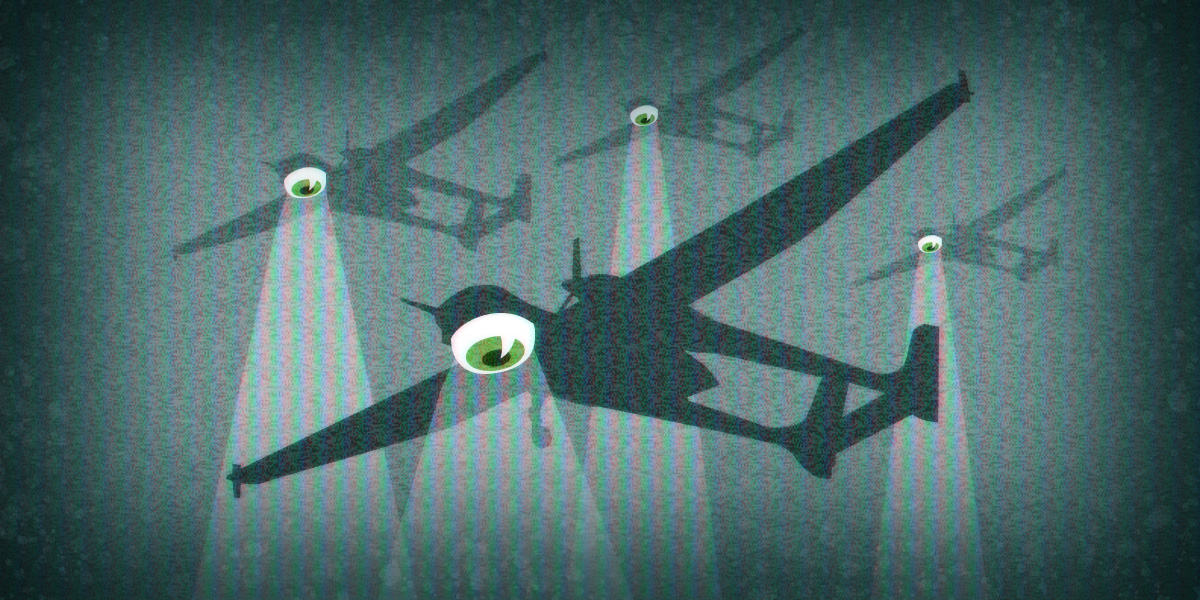[ad_1]
Police are using their drones as flying automated license plate readers (ALPRs), airborne police cameras that make it easier than ever for law enforcement to follow you.
“The Flock Safety drone, specifically, are flying LPR cameras as well,” Rahul Sidhu, Vice President of Aviation at Flock Safety, recently told a group of potential law enforcement customers interested in drone-as-first-responder (DFR) programs.
The integration of Flock Safety’s flagship ALPR technology with its Aerodome drone equipment is a police surveillance combo poised to elevate the privacy threats to civilians caused by both of these invasive technologies as drone adoption expands.
A slide from a Flock Safety presentation to Rutherford County Sheriff’s Office in North Carolina, obtained via public records, featuring Flock Safety products, including the Aerodome drone and the Wing product, which helps convert surveillance cameras into ALPR systems
The use of DFR programs has grown exponentially. The biggest police technology companies, like Axon, Flock Safety, and Motorola Solutions, are broadening their drone offerings, anticipating that drones could become an important piece of their revenue stream.
Communities must demand restrictions on how local police use drones and ALPRs, let alone a dangerous hybrid of the two. Otherwise, we can soon expect that a drone will fly to any call for service and capture sensitive location information about every car in its flight path, capturing more ALPR data to add to the already too large databases of our movements.
ALPR systems typically rely on cameras that have been fixed along roadways or attached to police vehicles. These cameras capture the image of a vehicle, then use artificial intelligence technology to log the license plate, make, model, color, and other unique identifying information, like dents and bumper stickers. This information is usually stored on the manufacturer’s servers and often made available on nationwide sharing networks to police departments from other states and federal agencies, including Immigration and Customs Enforcement. ALPRs are already used by most of the largest police departments in the country, and Flock Safety also now offers the ability for an agency to turn almost any internet-enabled cameras into an ALPR camera.
ALPRs present a host of problems. ALPR systems vacuum up data—like the make, model, color, and location of vehicles—on people who will never be involved in a crime, used in gridding areas to systematically make a record of when and where vehicles have been. ALPRs routinely make mistakes, causing police to stop the wrong car and terrorize the driver. Officers have abused law enforcement databases in hundreds of cases. Police have used them to track across state lines people seeking legal health procedures. Even when there are laws against sharing data from these tools with other departments, some policing agencies still do.
Drones, meanwhile, give police a view of roofs, backyards, and other fenced areas where cops can’t casually patrol, and their adoption is becoming more common. Companies that sell drones have been helping law enforcement agencies to get certifications from the Federal Aviation Authority (FAA), and recently-implemented changes to the restrictions on flying drones beyond the visual line of sight will make it even easier for police to add this equipment. According to the FAA, since a new DFR waiver process was implemented in May 2025, the FAA has granted more than 410 such waivers, already accounting for almost a third of the approximately 1,400 DFR waivers that have been granted since such programs began in 2018.
Local officials should, of course, be informed that the drones they’re buying are equipped to do such granular surveillance from the sky, but it is not clear that this is happening. While the ALPR feature is available as part of Flock drone acquisitions, some government customers may not realize that to approve a drone from Flock Safety may also mean approving a flying ALPR. And though not every Flock safety drone is currently running the ALPR feature, some departments, like Redondo Beach Police Department, have plans to activate it in the near future.
ALPRs aren’t the only so-called payloads that can be added to a drone. In addition to the high resolution and thermal cameras with which drones can already be equipped, drone manufacturers and police departments have discussed adding cell-site simulators, weapons, microphones, and other equipment. Communities must mobilize now to keep this runaway surveillance technology under tight control.
When EFF posed questions to Flock Safety about the integration of ALPR and its drones, the company declined to comment.
Mapping, storing, and tracking as much personal information as possible—all without warrants—is where automated police surveillance is heading right now. Flock has previously described its desire to connect ALPR scans to additional information on the person who owns the car, meaning that we don’t live far from a time when police may see your vehicle drive by and quickly learn that it’s your car and a host of other details about you.
EFF has compiled a list of known drone-using police departments. Find out about your town’s surveillance tools at the Atlas of Surveillance. Know something we don’t? Reach out at [email protected].
[ad_2]
Source link

Leave a Reply